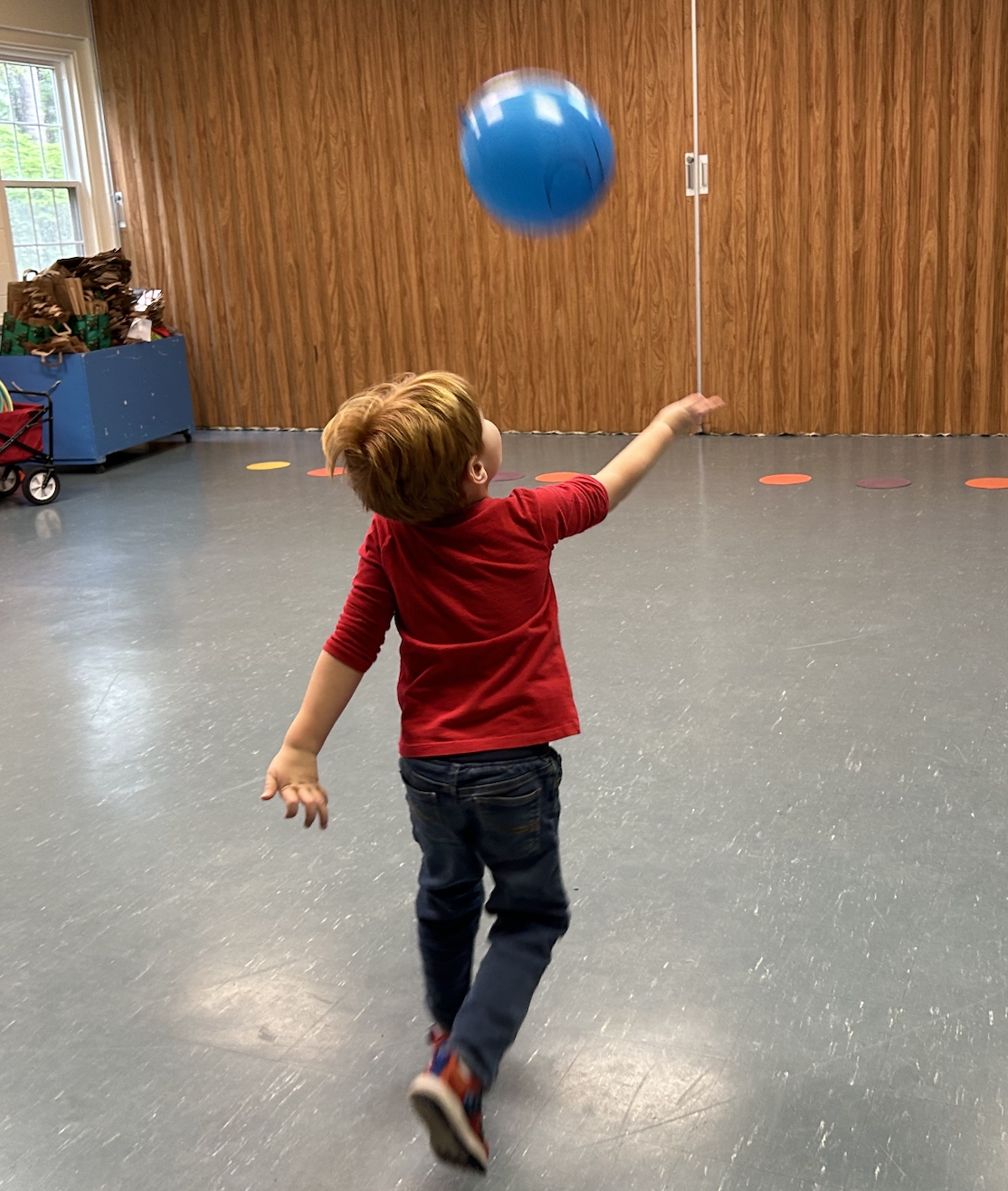I started my business in 2000 when my children were preschoolers. As a health coach and group fitness instructor, I believed health was vital in childhood and I was concerned about the statistics I was seeing on the declining health of our nation’s kids.
I knew I liked my children better after we had been to a playground so the early premise of my business was to get kids to run, a lot, and then give them back to their teachers as happier kids who were on a path to wellness. I was right. But I quickly learned there was a lot more involved. Fortunately, I started with a school that was open to the idea, but they paid me next to nothing as I practiced and honed my skills leading big-body play and skating that thin line between fun and absolute chaos. At first, I continued to believe health was the most important outcome of my classes, but during those years, I began to notice a dramatic decline in kids’ core strength. As a fitness professional that was concerning. But I didn’t know the half of it.
Most fitness professionals and coaches know that core strength drives everything that we do whether it is to pick up laundry baskets, dead lift, kick a ball or ride a bike. Many also know that core strength is vital to sitting comfortably in a chair at a desk and holding and moving a pencil with success. The interesting thing to note is that a lot of teachers don’t know this. This was my crack in the door. I did everything I could to learn what moving and learning had to do with each other and the impact sedentary behaviors had on the wiring of the brain, and a child’s ability to attend and perform in the classroom. Once I did, I used that information to get my foot in the crack in the door.
A Pivot to Play® Coach who holds a Master’s in Education from a very prestigious state university told me she learned more about child development and classroom management in the Pivot to Play® Certification than she did in her master’s program. In other words, our teachers are not learning a lot about the brain-body connection to child development before they are sent into the classroom. And the result is frequently a chaotic classroom filled with frustration from both the students and the teachers. And in this post-pandemic world, that chaos is worse than it has ever been.
Let’s look at the facts:
- Children’s core strength has declined dramatically in the past two decades. A study out of the U.K. found a decline in core strength of 2.6% per year between 1998 and 2008, which corresponds directly with what I saw during those same years. Making matters worse, between 2008 and 2014 core strength declined 3.9% per year.
- Cardiovascular endurance in children is declining at a rate of 5% per decade which means kids are slower and struggling with aerobic movement more than ever. In 2013 it took kids 90 seconds longer to run a mile than it took kids in the 1980s. We have seen another decade pass since these studies and we have had a pandemic that severely limited physical activity. Based on logic, we can assume these figures are worse today. Even for folks out of the fitness and coaching business, these should be shocking and very concerning trends.
As coaches, we know that core strength helps kids concentrate in school because they are comfortable sitting and can control and use their appendages appropriately. We also know that aerobic movement turns on the executive brain improving behavior, cognition and ultimately learning. It is the benefit of our profession that we know the strengths and skills that are built in big-body physical activity leads to calmer kids, who can manage their bodies because their brains know how to use them for work and play. In other words, what we know can help kids (and teachers) succeed.
So the question is, how do we do this?
- Start small and young. Consider small, independent, and church-based preschools. Typically, these preschools do not have dedicated PE programs. And despite the fact that purposeful big-body play like the Pivot to Play® curriculum isn’t really PE but more foundational pre-PE, it is how it is pigeonholed. And that is ok. Getting a foot in the door as a PE or movement program alternative is fine. Once the program has started and teachers see how your program brings calmer bodies ands minds then they become the advocates to encourage more programming and often lean on their director for more of what you have to offer.
- Offer Professional Development/In-Service and Training. Teachers need professional development hours every year. Consider offering to speak to teachers for an hour on the value of big-body play to their students’ social, emotional, behavioral, and cognitive success. Teachers today are overworked and underpaid and need a lot of support. When their classrooms are chaotic and they have children with the wiggles, they need answers and solutions. Approach this from their perspective. What games can be played in a classroom or a small space that require a lot of physicality and big muscles but don’t take up a lot of space? What games can even incorporate learning? The more work you take off their plate the better. So come prepared to play.
- Think broadly and write. Write an op-ed for your local paper on the vital importance of movement and big-body play. We all know this is a sit-to-learn, teach-to-tests education system our children are in, and what we offer as play specialists help move the needle on learning far more than extra sitting or extra testing. Writing a letter like this demonstrates your expertise and exposes you to a wider audience.
- Offer demonstrations. If you can get into a school for a demonstration or one-off session, look for opportunities to showcase your expertise with the teachers. First, be sure they are open to your being there. Some are very protective of their students and are skeptical of outsiders or “wasteful” playtime. Watch all their body and facial clues to guide you. Then if possible, start conversations with them while the kids are immersed in a game. Use your knowledge base and offer help very delicately. For example, “I see that Billy is toe walking every time he runs. Is that what he usually does?” If the teacher knows what toe walking is, likely she will be ready to jump into a conversation about it providing an opportunity for you to dig a little deeper: are his parents addressing it? Can I give you some more information to help support you? This kind of conversation lends weight to your expertise and raises you up in their eyes as a support for their efforts to help their students succeed.
- Be mindful of pricing. Create two levels of pricing to build your base. Some schools may want to have your program every week for the whole school year, or for a multi-week series for all their children. This should be a set hourly price which will help schools budget. For younger preschool-aged children, we recommend 20-minute sessions which means the school could have 3 classes participate in the course of one hour. That is a hefty bang for the buck for the school while you get exposed to more kids and begin to showcase your expertise. Have second-level pricing that is for enrichment or after-school programming. This is something the parents sign up for and pay you a per child/per day price. This kind of program is particularly successful when the enrichment is right after school and on the school grounds. It is very convenient for parents and it makes the school look good as they offer an additional service at no cost to them. Sometimes schools will ask for a “rental” fee or a nominal cost for your using their space but it can always be padded into your price.
- Make your program more play and physicality and less sport. Most kids today struggle with fundamental physical skills. Preschoolers and many elementary school-aged kids are struggling to skip because they haven’t yet mastered galloping. Many can’t run with finesse and their general movements are very clumsy because they have not spent enough time getting physical and moving their bodies in play. This makes sport and sport skills harder than they should be because the basic foundation has not been built. Games that help kids build cardiovascular endurance, core, upper body, lower body, and grip strength while practicing perceptual motor skills are vital before attempting to teach throwing, striking, or catching. Additionally, these post-pandemic kids are struggling more than ever with sensory skills. These skills impact their ability to attend, understand their bodies, understand force, and understand their place in the world. When working with kids today, much of what they need is pre-PE foundational physical skills in a fun, playful environment where they can learn what their bodies can do in the trial and error of play without the pressure of competition or comparison.
Bottom line? We coaches have a profound knowledge base to support a child’s development whether it is in school or on the playing field. The more we can support their physical strength and skill development the more we can help support their success on the playground, on the sports field, in the classroom, and in life.

Ready to Work in Schools for Real?
The Pivot to Play® Certification is designed to help you maximize your knowledge of the physical by leveling up your expertise in the brain-body connection as it services the learning trajectory of a child. Using the Pivot to Play® Learning Pyramid as a foundation to support big body play for calming minds and bodies to support academic success, the Pivot to Play Certification is designed to give you the tools to work in schools and speak knowledgeably with educators on the value of moving for learning.
Curious? Learn more here. Ready to jump in? Get certified here.

Body Awareness FREE
Get a taste for how we operate and use our programming for classroom success. This quick webinar will dive into this important perceptual motor skill and give you key takeaways including:
- What body awareness looks like when it is not well-developed
- What it looks like when it is well developed
- How it impacts the classroom experience
- How it impacts friendship development
- Games and activities to strengthen body awareness
Get yours here.
Are You Ready to Pivot to Play®?
Join the tribe of coaches who are making an impact on kids’ ability to focus, attend and learn. Join this tribe of dynamic coaches whose enthusiasm and playfulness help kids gain confidence in what their bodies can do in and out of the classroom. Be a teacher’s hero by helping restore calm and progress to classrooms.
